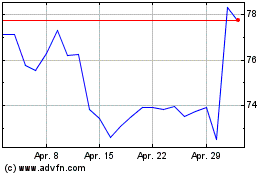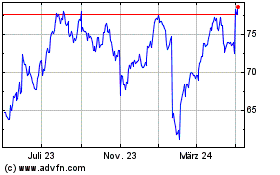By Jacob Bunge And Eyk Henning
The potential merger of DuPont Co. and Dow Chemical Co. could
spur agricultural rivals to forge their own partnerships, further
shrinking the handful of companies that dominate the global seed
and pesticide business.
The two U.S. chemical giants are considering a combination that
would lead to a three-way split of their businesses post merger,
The Wall Street Journal reported this week. Uniting Dow and
DuPont's agricultural units would create a deeper pesticide
portfolio against weeds, bugs and fungi and a stronger franchise in
genetically modified seeds, ratcheting up competition with Monsanto
Co., the top global seller of seeds, and Syngenta AG, the world
leader in pesticides.
Dow and DuPont get most of their revenue from sales of chemicals
and materials, but a combination wouldn't sharply shift the
competitive landscape in that relatively fragmented industry. A
deal would, however, be the first major shake-up in more than a
decade for the seed-and-pesticides business currently led by six
firms including Germany's Bayer AG and BASF SE. Those companies are
contending with weak crop prices world-wide that have pinched
farmers' wallets and forced them to curtail spending on everything
from seeds to fertilizer and tractors.
"It is just the beginning" of consolidation in that area, said
Mark Gulley, principal of New York-based chemicals consultancy
Gulley & Associates LLC. "The industry's overdue."
Monsanto kicked off the current deal making wave last spring
when the biotech seed giant proposed to buy Swiss rival Syngenta.
After unsuccessfully courting Syngenta investors and sweetening its
offer to $46 billion in cash and stock, Monsanto dropped its
pursuit in August, though Monsanto executives have continued to say
the deal would have been a good one.
Syngenta has at least one other suitor--China National Chemical
Corp., or ChemChina--interested in acquiring the company, people
familiar with the discussions said. The state-owned Chinese company
isn't currently a major force in the agriculture sector, but
biotech crops' capacity to simplify pest control and improve yields
has gained prominence in China.
Though China's government has put restrictions on cultivating
GMO crops, the country is investing in plant biotech and pushing to
consolidate its fragmented seed industry in an effort to modernize
its agricultural industry. Chinese firms' expansion has contributed
to overcapacity in some parts of the chemical industry, pressuring
profit margins.
Some Syngenta investors say the company's board should consider
deals since a Dow and DuPont merger would shrink the playing
field.
"If Dow and DuPont are gone. that does reduce the favoured
options for Syngenta," said Folke Rauscher, a Swiss-based investor
relations executive and Syngenta shareholder who in October helped
form a shareholder group to push for changes at the company.
Mr. Rauscher, who met with Syngenta chairman Michel Demaré in
late November to discuss his group's concerns over Syngenta's
stand-alone prospects, said the group would refresh its call for
Syngenta to begin an auction process.
Monsanto has stressed its own independent strengths after
dropping its Syngenta pursuit. But executives have said the company
continues to eye potential deals as a way to expand Monsanto's
chemicals franchise, a business the company had de-emphasized over
the past 15 years as it focused on developing biotech seeds.
"We like where we sit today, both with what we have in hand
right now, as well as the ability to pursue additional options," a
Monsanto spokeswoman said. Acquisitions must fit Monsanto's
strategy, allow for cost reductions and provide new ways to grow.
"There are options out there that can meet those objectives," she
said.
"Despite a lot of noise, we have no pressure to act rashly," she
said.
Industry executives say mergers could help develop new seed and
chemical products faster, and strip out costs in a research-heavy
business. It can cost about $136 million to identify helpful genes,
successfully insert them into crop seeds and secure regulatory
clearances around the world, according to a 2011 study by Phillips
McDougall Ltd.
For BASF and Bayer, a counterbid for Syngenta would be costly
and would likely require significant divestitures to resolve
antitrust concerns, say analysts. A sale of Syngenta to ChemChina,
a relatively minor competitor in the global market for agricultural
chemicals, wouldn't pose the same competitive threat to seed rivals
as a Syngenta-Monsanto combination, bankers say.
Unlike a combination with Monsanto, a tie-up with ChemChina, one
of China's largest state-owned businesses, likely would face fewer
antitrust hurdles, people familiar with the situation said.
Some Syngenta investors prefer Monsanto as a partner. "The
synergies in terms of costs, distribution and R&D would create
huge value for shareholders and establish a dominance that would be
difficult for any competitor, including a Dow/DuPont, to rival,"
said Magnus Spence-Jones, an analyst at fund manager THS Partners
LLP.
Merging Dow and DuPont could provide an opportunity for the
German companies to expand their North American seed franchises,
which lag those of rivals. The combined company might keep DuPont's
highly regarded seed business, which holds 35% of the U.S. corn
market and a third of soybeans, and divest Dow's smaller units to
ensure antitrust clearance, according to analysts.
"If Dow's seed business is going to be up for sale, you can be
sure the Germans are going to bid on it," said Mark Connelly, an
analyst with CLSA Ltd.
A spokeswoman for BASF declined to comment. A spokesman for
Bayer said that agriculture "is a core business of Bayer" but
declined to comment on specific deal possibilities.
John Revill contributed to this article.
(END) Dow Jones Newswires
December 10, 2015 19:59 ET (00:59 GMT)
Copyright (c) 2015 Dow Jones & Company, Inc.
DuPont de Nemours (NYSE:DD)
Historical Stock Chart
Von Jun 2024 bis Jul 2024

DuPont de Nemours (NYSE:DD)
Historical Stock Chart
Von Jul 2023 bis Jul 2024
